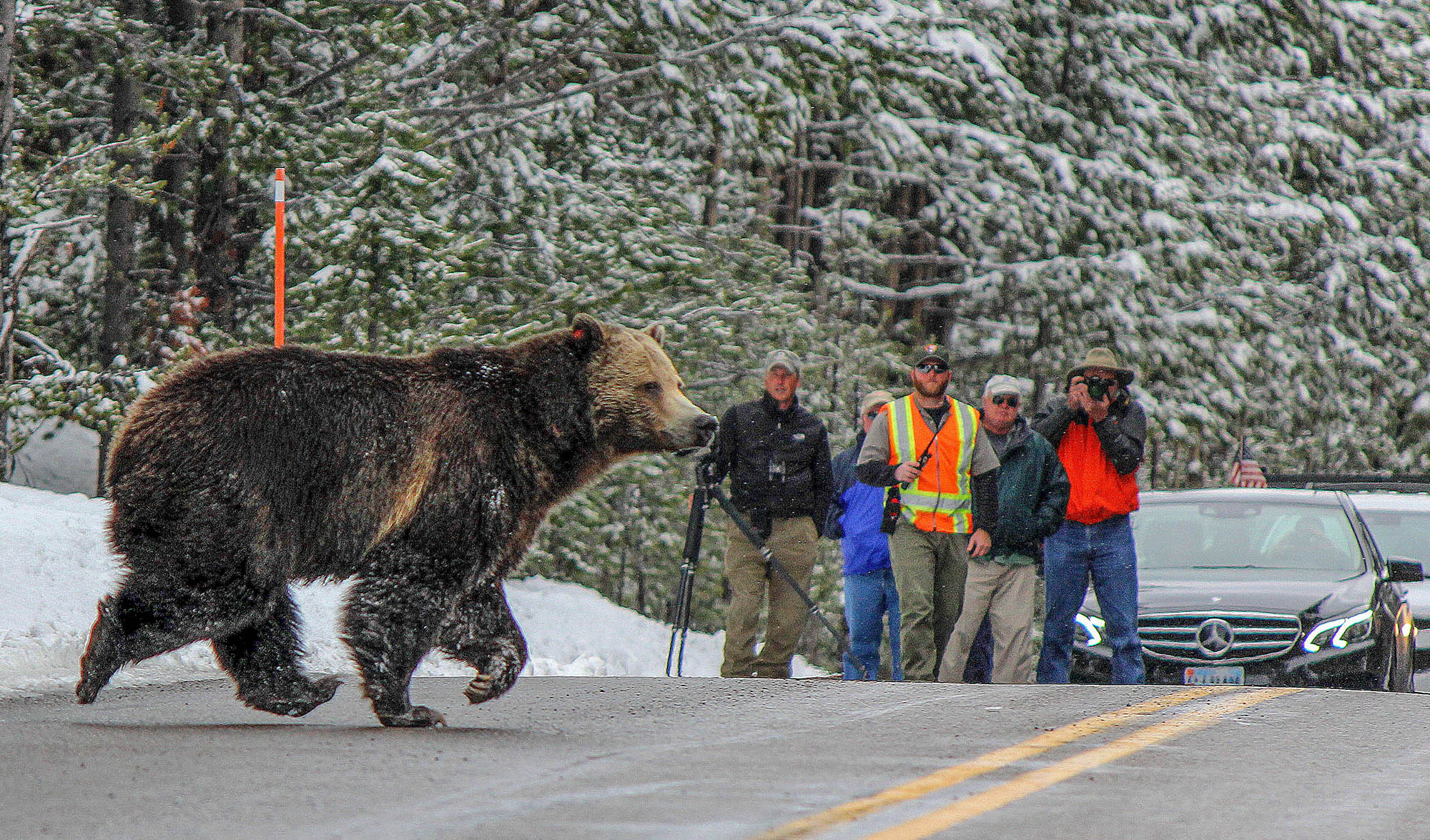I still blame The Black Stallion and Flicka for my unrealistic expectations when it comes to interacting with horses. The same is true for my experiences with seeing bears… but sometimes we just have to grow up and unlearn what Hollywood taught us as kids.
My first bear sighting was in the Rocky Mountains northwest of Colorado Springs on an early summer afternoon. Seeing the momma bear and her two cubs scampering off into the woods is something neither I, nor my three kids, will ever forget.
But as a mother myself, I began scouring the recesses of my mind for what I’d read about bear sightings. What should I do next? How should I prepare for the next encounter? Would I be able to protect my own cubs if we crossed paths again? We WOULD be crossing paths again, right? You never just see a bear once in the movies!
Alas, they never reappeared. It was just like MOST real-life bear encounters. Low-key, brief, and perfect in every way. We saw, they left, and all species lived in peace with one another.
Yes, adrenaline-pumping movies may have primed me to expect more trouble. But it was for moments like these that I’d done my due diligence and researched what to do if I saw a bear in its natural habitat. I had unlearned my Hollywood expectations when it came to bear behavior and prepared myself for a real-life encounter.
You should too.
Let’s go over all that now – how to prepare for an adventure in bear country, what to do in case you meet one, and if you need to do anything after an encounter.

What to Bring With You When Exploring Bear Country
When you’re heading into bear country there are special safety precautions to take. Besides all the regular things like letting someone know where you are, scheduling a return time, carrying a first aid kit, and carrying an emergency communication device, there are also bear-specific tools to have handy.
Bear Bells
Bells are a popular addition to a hiker’s gear set, and you may already have them. But they’re actually not really loud enough to be heard from very far away, and they are an annoyance to other hikers. Keep wearing one if you want, but talking while you walk and giving a little applause to the beauty around you from time to time is more likely to alert a bear of your approach. Pay attention to your surroundings as well – stop, listen, and watch for signs so you can avoid bears that may be unaware of you.
Bear Spray
Bear spray is the defensive option you hope you never have to use. This tool is for defending yourself during very close encounters… like charges. It’s a super-powered pepper spray designed to stop a bear’s charge before contact is made by causing temporary blindness and irritation of the upper respiratory tracts. Be sure and research your brand to know its range. You don’t want to take your shot on a charging bear before it’s close enough! Learn when and how to use bear spray and always keep it handy. It won’t do you any good in your pack. Also, be sure and check with the specific regulations of your destination. For instance, Yosemite explicitly forbids carrying or using bear spray or pepper spray.
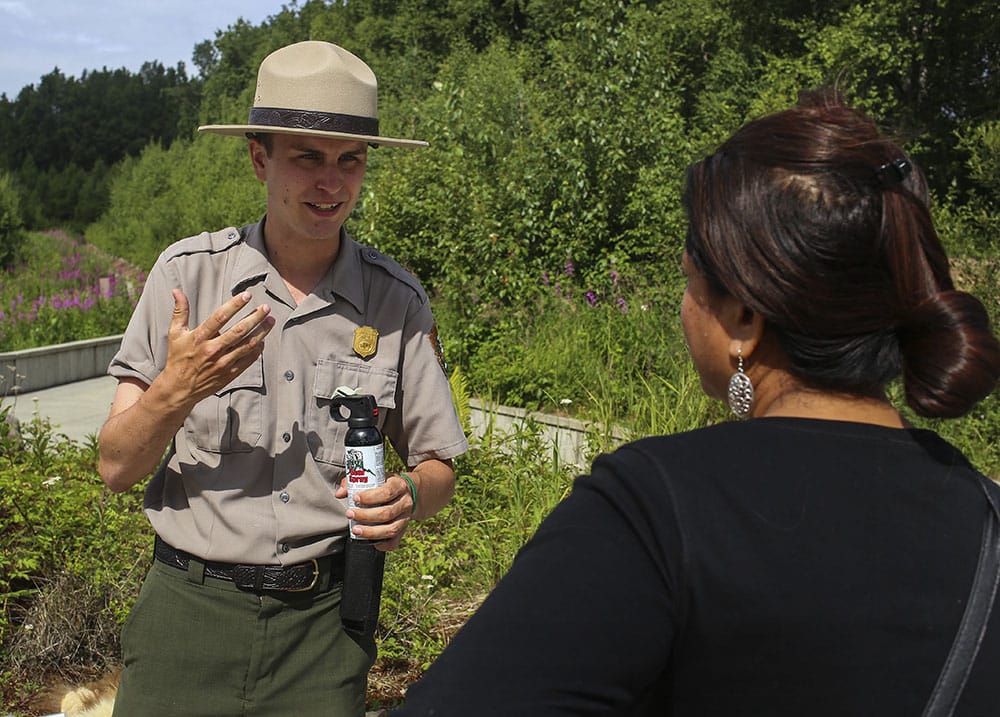
What to do if you see a bear while hiking
Close-range encounters with bears can potentially trigger a defensive response, so it’s important that you give them plenty of room. Don’t approach, crowd, or surprise bears.
Step 1 – Let the Bear Know You’re There
You may have a bell, but if you see a bear you can’t avoid, alert it to your presence from far away. Raise your voice and wave your arms to help it see you and recognize that you’re human. Talk slowly and use a deep tone to avoid any risk of sounding like a scared, wounded target. Your goal is to sound confident, but not aggressive… you’re not trying to start something. It’s like standing up to the bully but not really wanting to throw punches either, ya’ know?
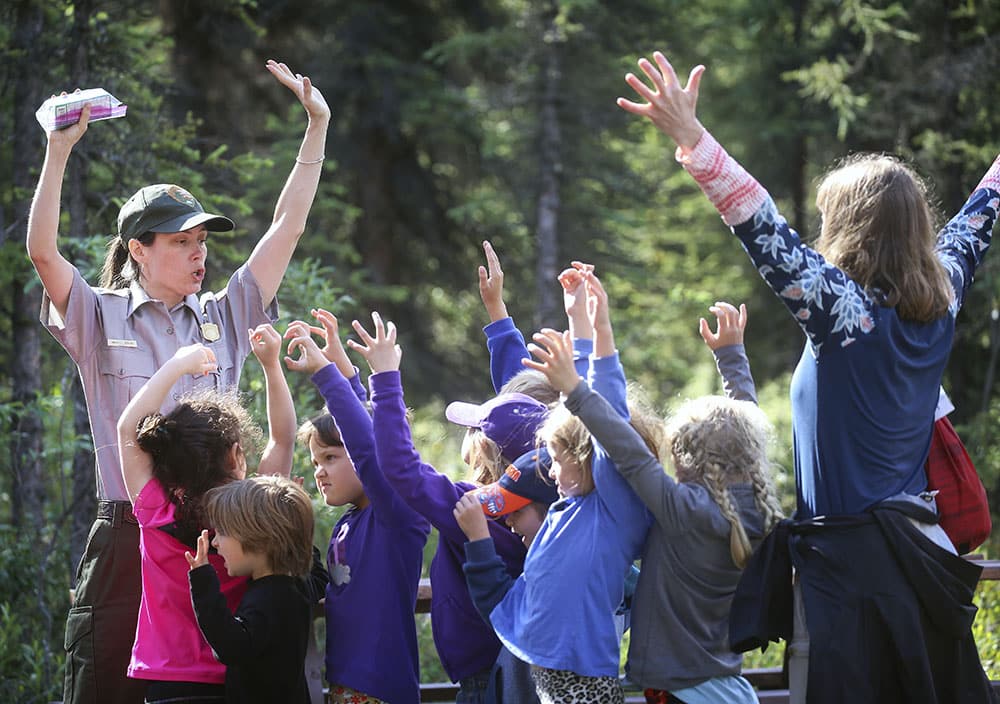
Step 2 – Move Away
If it isn’t approaching you, give the bear some space by slowly moving away while keeping an eye on it. But if it starts to approach or follow, stand your ground. Moving away from an approaching bear can encourage it to follow you. Standing your ground and talking in a low calm voice is reassuring to a defensive bear but also mildly assertive to a bear that is seeing if it can push you around.
Step 3 – Monitor Reactions
After you’ve made some noise and given the bear space, it’s time to see how he responds.
Is he ignoring you? If so, take a deep breath and relax. Just keep moving away if he’s stationary or wait for him to disappear if he’s shuffling away.
Is he following you nonchalantly? If so, stay calm and keep slowly moving away. Find a fork in the trail and move down one way to see if he’ll choose the other path or move off the trail to see if it just wants to pass by. He could just be headed the same way and yielding to him is all that’s needed to resolve the situation peacefully.

Is he acting agitated? This is something you might see in a defensive bear that you surprised. Standing on his hind legs doesn’t signal aggression. Getting taller provides a better vantage point to gain information, so he could just be curious and want a better look. Instead, watch to see if he’s swaying his head back and forth, making deep huffing sounds, clacking his teeth as he stares at you, or swatting the ground. If this is what you’re seeing when you’ve given the bear every opportunity to get away from your presence, prepare yourself for a close encounter.
Step 4 – Respond to charges
There are two types of bear charges, but they can be difficult to distinguish. In any charge, the situation is already tense and the dynamics can change quickly. The good news is, your reaction could be the biggest determinant of whether the bear makes contact. Also, no matter what type of charge it is, how you react should be the same… standing your ground and radiating calm confidence, with bear spray in hand. Whatever you do, don’t panic, scream or run. That makes you look like prey, or at least like something fun to chase.
Defensive displays are a tactic designed to scare off potential threats. Often they look like short hop charges that end just after they start. When a bear is bluffing he’ll generally keep his head up and ears forward. You also may or may not see other signs of irritation as described above.
Stay calm and hold your ground. If you have your bear spray, use it. But even if you don’t have it, DO NOT run away. Stand still, get as big as possible and keep talking to the bear in a deep voice.
Real charges are different only in that the bear has already decided that you’re a menace or prey. They can look different from the defensive display of a faux charge because the bear will usually drop its head, flatten its ears, and may be huffing and clacking its teeth.
Your response, however, should remain the same. Use your bear spray if you have it. Aim for the face and wait until the bear is close enough to ensure maximum impact of the aerosol particles. It’s also important to be aware of wind direction and do what you can to minimize blowback! No matter what, try to stay in place and talk calmly to the bear to de-escalate the situation. If you stand steady, bears will sometimes swerve or stop short at the last minute.
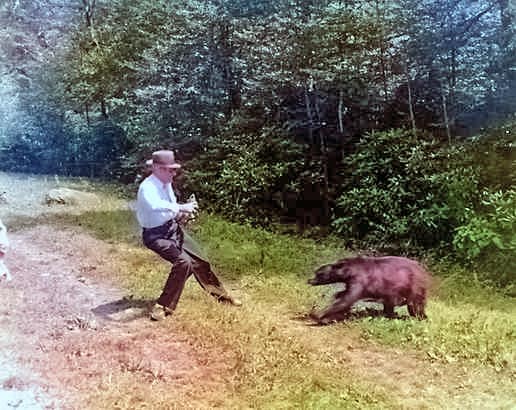
Step 5 – Defense from attacks
If all precautions fail and a bear manages to make bodily contact with you, your response will depend on whether or not the bear you’re dealing with is reacting defensively. Did you startle or crowd it? Did your dog harass it? Is it acting agitated and upset?
If a defensive bear is attacking, get on your stomach and cover your head/neck as best as you can with your hands and arms. If you’re wearing a pack, keep it on to protect your back. Spread your legs out and use them to keep the bear from rolling you over. Staying still usually ends the aggression. After he disengages, remain calm and on the ground to allow the bear time to leave the area. Although black bears rarely attack defensively, females with cubs have attacked when harassed by dogs.
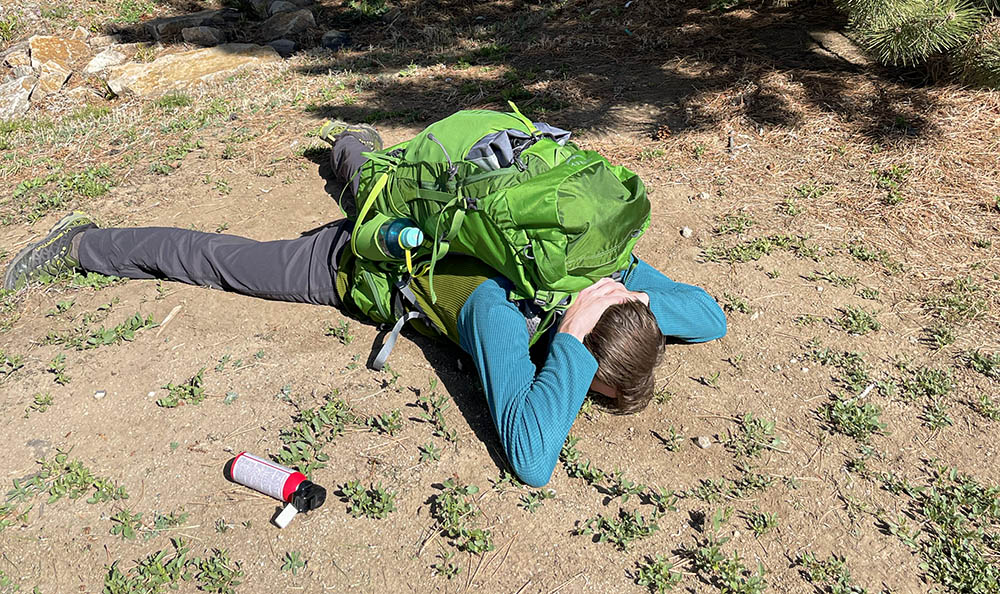
If the bear attacking you wasn’t defensive, but stalked you or ripped into your tent, fight back with everything you have regardless of the species. In this situation, it is demonstrating that it’s in a predatory mindset and YOU are the prey. In this case, the only proper response is to fight, regardless of its species. Use anything within reach as a weapon and concentrate all your efforts on his face/head. Be loud. Be aggressive. DO NOT PLAY DEAD.
Step 6 – Report to the proper authorities
If you have a bear encounter, report it to park officials. Be prepared to describe the animal, its behavior, and where you crossed paths. Helping officials know the current state of the park’s bears helps them know how best to manage them. It can also prevent issues if the public needs to be warned or sections of a campground or trail need to be temporarily closed to avoid dangerous encounters.
What to do if you see a bear in camp
The most important step to protect yourself from bears when camping is proper food management. Unfortunately, campers who haven’t been taught how to camp in bear country have conditioned some bears to know that easy calories can be found in campsites. Now, organizations like BearWise are working to undo the damage with educational materials that help minimize human bear conflicts.
Always cook your food away from where you plan on sleeping. You also want to store your food a good distance away as well. There’s no need to attract bears while you catch some z’s! At least 70 big steps is a good rule-of-thumb for both situations.
Using a bear canister instead of a bag is crucial to ensure a bear’s efforts aren’t rewarded and to teach them to not rely on campers for sustenance. You can see how the BearVault stopped this black bear from accessing a camper’s stash. No easy snacking for him!
Proper food storage is how we protect ourselves, bears, and future generations of both species.
Some campsites will provide bear lockers and many parks also have regulations about food storage. Be sure and check the rules before you head towards camp.
If you’ve stored your food properly and still get an unwanted visitor, follow the same rules of engagement as you would on the trail. You are, after all, still on his home turf!
Don’t pick a fight unless your personal safety is at risk. If a curious bear is sniffing around and knocking stuff over, it’s nothing that can’t be fixed. If an irritable bear is tearing up your hammock, it’s nothing that can’t be bought. When noise doesn’t dissuade him, you don’t want to force the issue for the sake of some gear.

Knowing what to do when you see a bear keeps both of you safe
Respecting wildlife does more than just keep your food safe so you can enjoy a campfire breakfast after a night under the stars. It preserves the ability to enjoy nature for future generations.
Protects bears from humans.
Keeps the wild things wild.
The first step to having peaceful bear encounters is to go beyond Hollywood portrayals and learn how real-life scenarios are likely to play out. You’re doing that right now. Great work, adventurer, on educating yourself! Together, we can enjoy bear country safely and minimize interspecies conflicts.

With Input From:
John Hechtel, Bear Biologist
John is one of the premier experts in bear safety. With over 30 years of experience in bear management with Alaska Fish & Game, he has also written and produced several groundbreaking videos on bear safety. John currently serves as president of the International Association for Bear Research and Management.

Guest Author:
Jessica Cockroft
Jess merges her passion for words and an insatiable longing for adventure as an outdoor freelance content writer and marketer. When she’s not busy stringing words together you’ll probably find her planning another camping trip for her crew of kids or taking care of the homestead. You can find her on LinkedIn and Instagram, as well as on her own website.

